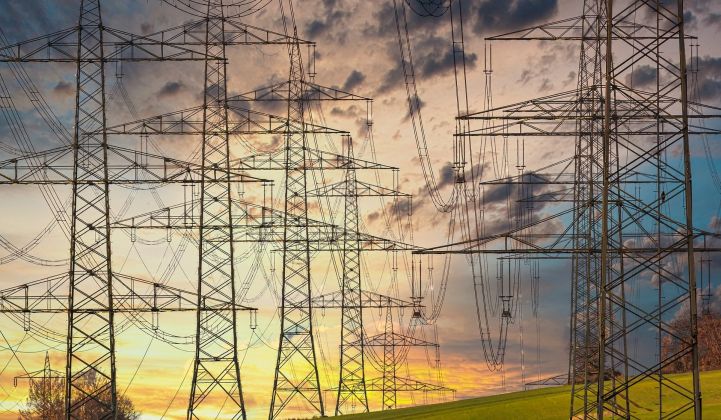Demand for renewables from the growing number of states and utilities with 100 percent clean energy goals is almost certain to outpace their ability to supply it from within their own borders. But the time needed to build transmission lines to move the power around is running out.
On Wednesday, research firm ScottMadden released a new in-depth study that describes the complicated, region-by-region state of play for the U.S. transmission grid. It’s an exhaustive update of key policy developments, largely focused on the regional transmission organizations and independent system operators that manage the transmission system for about two-thirds of the country — from the effects of “polar vortex” winter events on grid reliability to California’s moves to expand its energy market across the Western U.S.
The study was commissioned by Wires, a nonprofit group representing utilities, grid operators, transmission owners and developers.
Many of its arguments for transmission investment are familiar from years past. But they have a new sense of urgency from the increasing number of states and utilities setting 100 percent clean energy goals, Larry Gasteiger, Wires group executive director, told GTM.
From where it’s cheapest to where it’s wanted
“One of the key takeaways is the mismatch between where renewable supply is versus where it’s going to be needed to meet the various mandates and renewables goals being made in states and regions,” Gasteiger said.
In simple terms, the cheapest wind power is from the Great Plains and Intermountain West, and the cheapest solar power is from the Southwest and Southeast regions, and both need a way to reach faraway coastal markets.
New England, New York and California are bearing the brunt of this pressure, with estimated clean energy demand set to outstrip forecasted supply by 2030.
Meanwhile, the Upper Midwest, Texas and the Southeast are expected to have more supply than demand, while the Midcontinent Independent System Operator and the Southwest Power Pool face challenges integrating wind-rich northern regions to fossil-fuel-dependent southern regions.
Utilities and grid operators haven’t seen the same level of policy support that drove a boost in transmission investment around the turn of the last decade, said Cristin Lyons, a partner with ScottMadden who co-led the team that produced the study released Wednesday. That included the major buildout of transmission in Texas to bring wind power to markets under that state's Competitive Renewable Energy Zone policy and matching grants to utilities under the 2009 American Reinvestment and Recovery Act.
Since then, the challenges of siting, permitting and overcoming legal challenges across multiple jurisdictions have continued to stymie many projects, Lyons said.
Transmission investment has continued to rise over the past six years, from $17.7 billion in 2013 to an estimated $22.4 billion last year, the report notes. But the miles of transmission actually built has declined over the past five years, with only about 1,300 miles completed in 2018 versus a peak of about 4,500 miles in 2013.
FERC's failures and mixed signals from environmental advocates
Donna Fulton, director for federal regulatory policy at New England utility Eversource Energy, noted that support from the Federal Energy Regulatory Commission was critical to pushing through a series of transmission investments at the turn of the last decade.
Such investments have cut annual congestion costs in Eversource's system by more than $500 million and opened up gigawatts' worth of clean energy capacity.
“I think that was when FERC was at its strongest,” Fulton said, with key decisions such as FERC Order 1000 meant to create a new process for coordinated transmission planning and cost-sharing between states, grid operators and utilities.
But FERC Order 1000 hasn’t succeeded, ScottMadden’s report states, with “the general view across the industry that inter-regional planning processes are at best, stalled, and at worst, ineffective in identifying valuable projects."
Gasteiger, a 19-year veteran and former deputy director at FERC, noted that the agency is in the midst of considering how utilities in MISO and ISO New England territories can claim return on equity for transmission investments. While the issues at stake are complicated, FERC’s decision could set an important precedent for whether regulators can boost ROE to match the long lead times and legal uncertainty surrounding transmission projects, as compared to more predictable distribution investments.
“We need to have decision-making lining up with policy," Gasteiger said.
Meanwhile, states with clean energy goals face many disincentives to looking outside their borders for that supply, the ScottMadden report finds. Many states want to build projects within their borders to maximize the economic benefits or control their resource mix.
And while some environmental groups support interstate transmission, others have blocked projects on environmental grounds or promoted distributed energy resources as an alternative to utility-scale renewables.
But there’s little chance that states will be able to meet their more aggressive carbon-reduction goals with DERs or in-state resources alone, according to the report. That puts pressure on federal and state regulators to find ways to unblock the current bottlenecks in project development, Gasteiger said.
“If you’re looking at requiring these renewables as early as 2030, and you’ve got a lead time of as much as 10 years to plan, develop and put the infrastructure into service — we’re already at the brink of having to have stuff done right now.”




